Monday 15 July: The Modern Art Museum: Tate Modern
Section outline
-

Meeting Point:
Morning Session: On the QMUL campus, Arts One 1.25
Afternoon session: Tate Modern (take the District Line to Blackfriars). Go to the "Artist and Society" permanent display on Level 2 of the Natalie Bell Building and meet in Room 2 (this room is also called "A View from Sao Paolo: Abstraction and Society"). The meeting point is on the fourth page of this floor plan:
https://media.tate.org.uk/aztate-prd-ew-dg-wgtail-st1-ctr-data/galleries/TM_map.pdf
-
Log in through your QMUL account for access.